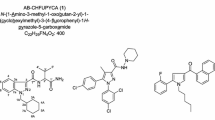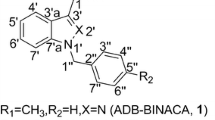Abstract
Two new types of synthetic cannabinoids, an AM-2201 benzimidazole analog (FUBIMINA, 1) and (4-methylpiperazin-1-yl)(1-pentyl-1H-indol-3-yl)methanone (MEPIRAPIM, 2), and three newly emerged phenethylamine derivatives, 25B-NBOMe (3), 2C-N-NBOMe (4), and a 25H-NBOMe 3,4,5-trimethoxybenzyl analog (5), were detected in illegal products distributed in Japan. The identification was based on liquid chromatography–mass spectrometry (LC–MS) and gas chromatography–mass spectrometry (GC–MS), high-resolution MS, and nuclear magnetic resonance analyses. Different from the representative synthetic cannabinoids, such as JWH-018, which have a naphthoylindole moiety, compounds 1 and 2 were completely new types of synthetic cannabinoids; compound 1 had a benzimidazole group in place of an indole group, and compound 2 had a 4-methylpiperazine group in place of the naphthyl group. Compounds 3 and 4 were N-o-methoxybenzyl derivatives of 2,5-dimethoxyphenethylamines (25-NBOMe series), which had been previously detected in European countries, but have newly emerged in Japan. Compound 5 had an N-trimethoxybenzyl group in place of an N-o-methoxybenzyl group. Data on the chemistry and pharmacology of compounds 1, 2, and 5 have never been reported to our knowledge.






Similar content being viewed by others
References
UNODC (2013) Global SMART update 2013—vol 10, September 2013. http://www.unodc.org/documents/scientific/Global_SMART_Update_10_web.pdf. Accessed Sept 2013
UNODC (2013) The challenge of new psychoactive substances. A report from the global SMART programme, March 2013. http://www.unodc.org/documents/scientific/NPS_2013_SMART.pdf. Accessed Sept 2013
EMCDDA (2013) EMCDDA/Europol, 2005/387/JHA, EMCDDA-Europol 2012 annual report on the implementation of council decision, Lisbon, May 2013. http://www.emcdda.europa.eu/publications/implementation-reports/2012. Accessed May 2013
Kikura-Hanajiri R, Uchiyama N, Kawamura M, Goda Y (2013) Changes in the prevalence of synthetic cannabinoids and cathinone derivatives in Japan until early 2012. Forensic Toxicol 31:44–53
Kikura-Hanajiri R, Uchiyama N, Kawamura M, Ogata J, Goda Y (2013) Prevalence of new designer drugs and their legal status in Japan. Yakugaku Zasshi 133:31–40 (in Japanese with English abstract)
Uchiyama N, Matsuda S, Kawamura M, Kikura-Hanajiri R, Goda Y (2013) Two new-type cannabimimetic quinolinyl carboxylates, QUPIC and QUCHIC, two new cannabimimetic carboxamide derivatives, ADB-FUBINACA and ADBICA, and five synthetic cannabinoids detected with a thiophene derivative α-PVT and an opioid receptor agonist AH-7921 identified in illegal products. Forensic Toxicol 31:223–240
Uchiyama N, Matsuda S, Wakana D, Kikura-Hanajiri R, Goda Y (2013) New cannabimimetic indazole derivatives, N-(1-amino-3-methyl-1-oxobutan-2-yl)-1-pentyl-1H-indazole-3-carboxamide (AB-PINACA) and N-(1-amino-3-methyl-1-oxobutan-2-yl)-1-(4-fluorobenzyl)-1H-indazole-3-carboxamide (AB-FUBINACA) identified as designer drugs in illegal products. Forensic Toxicol 31:93–100
Uchiyama N, Matsuda S, Kawamura M, Kikura-Hanajiri R, Goda Y (2013) Identification of two new-type designer drugs, a piperazine derivative MT-45 (I-C6) and a synthetic peptide Noopept (GVS-111), with a synthetic cannabinoid A-834735, a cathinone derivative 4-methoxy-α-PVP and a phenethylamine derivative 4-methylbuphedrine from illegal products. Forensic Toxicol. doi:10.1007/s11419-013-0194-5
Kikura-Hanajiri R, Uchiyama N, Kawamura M, Goda Y (2013) Changes in the prevalence of new psychoactive substances before and after the introduction of the generic scheduling of synthetic cannabinoids in Japan. Drug Test Anal. doi:10.1002/dta.1584
Uchiyama N, Kawamura M, Kikura-Hanajiri R, Goda Y (2013) URB-754: a new class of designer drug and 12 synthetic cannabinoids detected in illegal products. Forensic Sci Int 227:21–32
Lopyrev VA, Larina LI, Vakul’skaya TI, Shibanova EF, Titova IA, Voronkov MG, Liepins E (1982) Investigation of benzimidazoles. III. Transmission of the substituent effects in 2-substituted 1-methylbenzimidazoles studied by carbon-13 nuclear magnetic resonance. Org Magn Reson 20:212–216
Uchiyama N, Kawamura M, Kikura-Hanajiri R, Goda Y (2012) Identification of two new-type synthetic cannabinoids, N-(1-adamantyl)-1-pentyl-1H-indole-3-carboxamide (APICA) and N-(1-adamantyl)-1-pentyl-1H-indazole-3-carboxamide (APINACA), and detection of five synthetic cannabinoids, AM-1220, AM-2233, AM-1241, CB-13 (CRA-13), and AM-1248, as designer drugs in illegal products. Forensic Toxicol 30:114–125
Moir EM, Yoshiizumi K, Cairns J, Cowley P, Ferguson M, Jeremiah F, Kiyoi T, Morphy R, Tierney J, Wishart G, York M, Baker J, Cottney JE, Houghton AK, McPhail P, Osprey A, Walker G, Adam JM (2010) Design, synthesis, and structure–activity relationships of indole-3-carboxamides as novel water soluble cannabinoid CB1 receptor agonists. Med Chem Commun 1:54–60
Zuba D, Sekuła K, Buczek A (2012) Identification and characterization of 2,5-dimethoxy-4-nitro-β-phenethylamine (2C-N)—a new member of 2C-series of designer drug. Forensic Sci Int 222:298–305
Zuba D, Sekuła K, Buczek A (2013) 25C-NBOMe—new potent hallucinogenic substance identified on the drug market. Forensic Sci Int 227:7–14
Silva ME, Heim R, Strasser A, Elz S, Dove S (2011) Theoretical studies on the interaction of partial agonists with the 5-HT2A receptor. J Comput Aided Mol Des 25:51–66
Acuña-Castillo C, Villalobos C, Moya PR, Sáez P, Cassels BK, Huidobro-Toro JP (2002) Differences in potency and efficacy of a series of phenylisopropylamine/phenylethylamine pairs at 5-HT(2A) and 5-HT(2C) receptors. Br J Pharmacol 136:510–519
Acknowledgments
Part of this work was supported by a Health and Labor Sciences Research Grant from the Ministry of Health, Labour, and Welfare, Japan.
Conflict of interest
There are no financial or other relations that could lead to a conflict of interest.
Author information
Authors and Affiliations
Corresponding author
Rights and permissions
About this article
Cite this article
Uchiyama, N., Shimokawa, Y., Matsuda, S. et al. Two new synthetic cannabinoids, AM-2201 benzimidazole analog (FUBIMINA) and (4-methylpiperazin-1-yl)(1-pentyl-1H-indol-3-yl)methanone (MEPIRAPIM), and three phenethylamine derivatives, 25H-NBOMe 3,4,5-trimethoxybenzyl analog, 25B-NBOMe, and 2C-N-NBOMe, identified in illegal products. Forensic Toxicol 32, 105–115 (2014). https://doi.org/10.1007/s11419-013-0217-2
Received:
Accepted:
Published:
Issue Date:
DOI: https://doi.org/10.1007/s11419-013-0217-2




